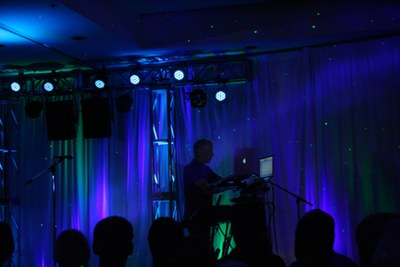Cruising through the cosmos on waves of soundby Dwayne Day
|
| One of the common themes in much of the music played on Hearts of Space over the decades has been spaceflight, and the journey out into the solar system and beyond. |
Electronic music has had ties to space, and science fiction, for far longer than Hearts of Space has been around. The 1956 classic Forbidden Planet had a soundtrack composed on an early form of synthesizer known as a ring modulator. Carl Sagan’s 1980 series Cosmos had an eclectically diverse soundtrack, but notably included Vangelis’ “Heaven and Hell,” which introduced the Greek electronic musician to a whole new audience. A year later he achieved greater fame, and an Oscar, after composing the soundtrack for Chariots of Fire, but earned a place in the science fiction pantheon with his 1982 soundtrack for Blade Runner. In 2001 Vangelis composed a symphony for the Mars Odyssey spacecraft. Directors, writers, and musicians all sought to connect the space age with new and unfamiliar music, using electronics and computers to compose music just like computers have directed the machines that venture off the Earth.
There are many kinds of electronic music, including techno and trance and electronica. But there has always been a mellower form, not intended for dance, but more atmospheric. So much of this music defies easy classification, which is why the name has shifted over the decades. For awhile it was known as “New Age,” a term that was also associated with spiritualism and hippies living in the Arizona desert talking about crystal energy. That term faded out in the 1990s and the current term is “ambient.” The fan base is diverse, as evidenced at the concert: there were certainly many middle-aged men in attendance, as well as a few hippies (it was, after all, northern California.) But there were also women and African Americans and even a few people in their thirties, although not many younger than that. There was a professor who teaches wildlife biology, and a retired TV actor and producer, and people who work in the more obscure segments of the music and film industries, not to mention those who design and experiment with electronic instruments. Many of them have been listening to Music from the Hearts of Space since the 1980s.
 Musician Steve Roach performing at Ambicon 2013. Roach’s complex sound compositions can evoke visions of traveling through the cosmos. (credit: D. Day) |
Music from the Hearts of Space has never confined itself to one specific type of music or only to electronica. “World Music” and the adoption of non-Western instruments and styles was also part of the show’s repertoire. And many of the artists the show has played over the years have adopted environmental sounds—running water, rain, thunder, crickets, wind, and the sounds of the jungle—into their soundscapes. The show’s focus has generally been music that seeks to tap into something deep in the mind and soul.
| The highly influential Steve Roach plays the kind of music that could accompany the coalescence of the planets from interstellar dust, or the emergence of life and consciousness from primordial elements. For most of his music, recreational drugs would only dilute the experience. |
But one of the common themes in much of the music played on Hearts of Space over the decades has been spaceflight, and the journey out into the solar system and beyond, because that has been one of the overarching themes of the genre—although the spaceship is optional. Ambient music has accompanied numerous space movies and television programs over the years. Eno’s song was composed for a 1983 documentary on the Apollo program, For All Mankind. Michael Stearns, who performed in front of an audience for the first time in a decade, frequently composes for planetarium shows. Robert Rich, who performed at the event using a bank of synthesizers as well as an aborigine didgeridoo, plays music that often sounds like a journey through the rings of Saturn or over the mountains of the Moon. The highly influential Steve Roach, who also performed, plays the kind of music that could accompany the coalescence of the planets from interstellar dust, or the emergence of life and consciousness from primordial elements. For most of Roach’s music, recreational drugs would only dilute the experience. It was no coincidence that the visual motif for the concert was the night sky, as stars climbed the walls and crossed the heads of the audience and the Northern Lights shimmered across the ceiling.
There are several streaming music websites that specifically adopt the spaceflight theme. Two sites, known as Soma, overlay NASA astronaut communications with Mission Control on top of ambient music. The website Bluemars.org plays music meant to evoke Mars covered in water.
But Hearts of Space still does it the best. You can subscribe to their site, cruise their archive, and find music that will allow you to journey off the planet, ascend into the heavens, or just clear your mind.
Or as Stephen Hill, the smooth-talking host of the program says, it is “slow music for fast times.”
